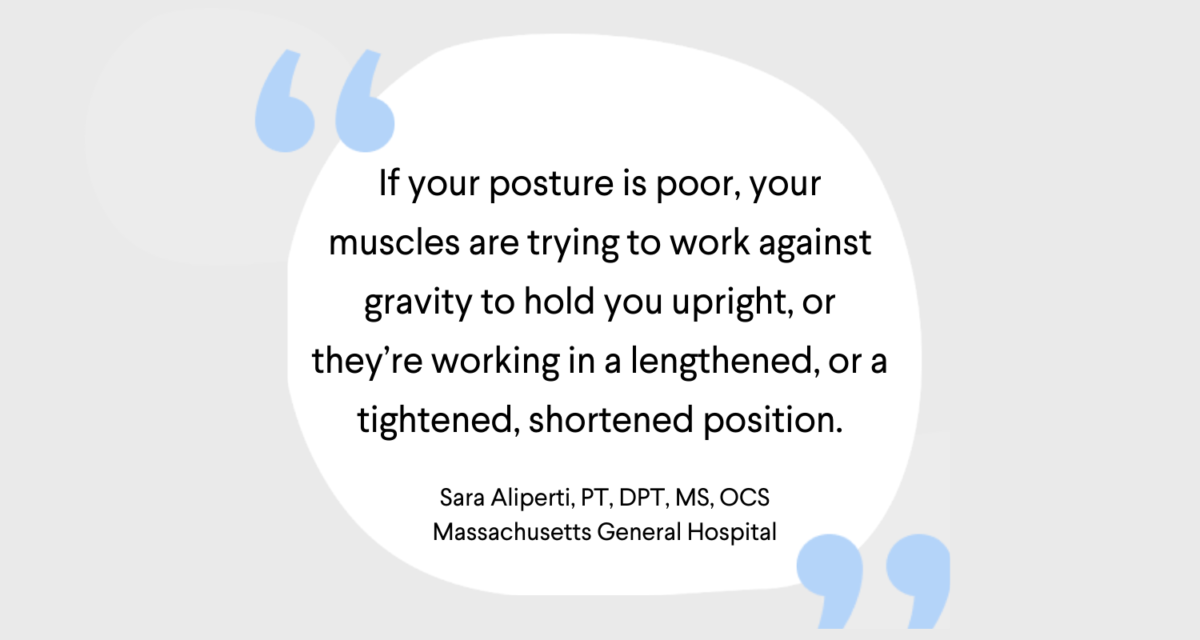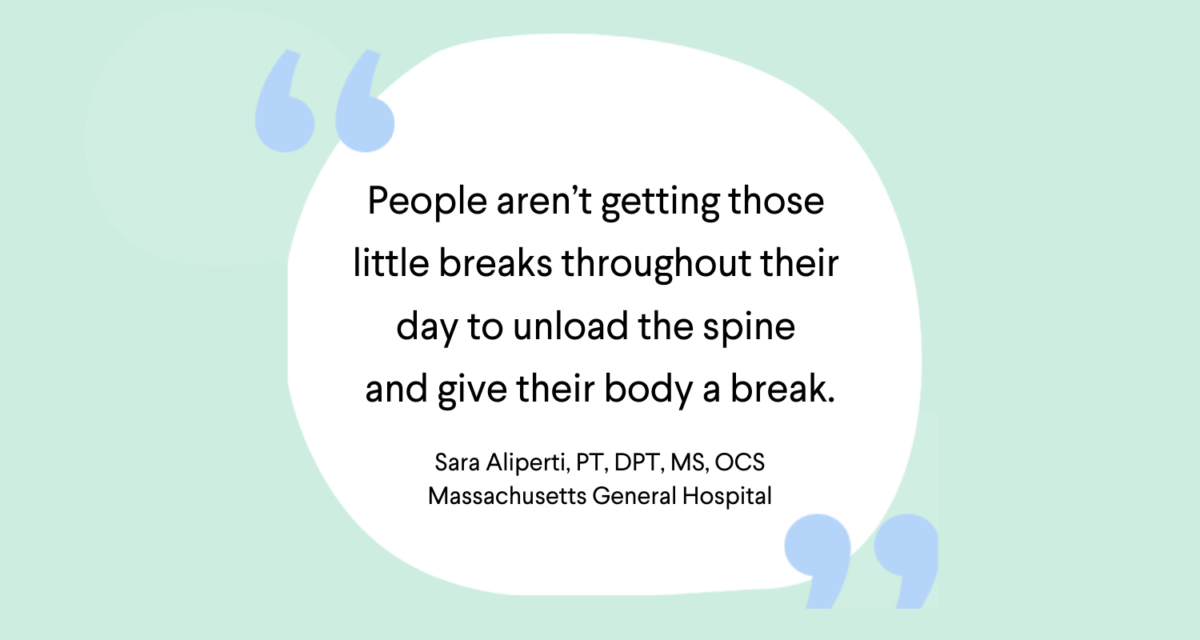If you’ve been working from home during the pandemic, you might have found yourself unexpectedly missing the little things from your daily life, like chatting with a coworker at the coffee machine, or the simple act of standing up and walking down the hallway to get to a meeting.
It turns out those small moments are more important to health than we might have expected.
While it’s still too soon for official studies to have been published about how the pandemic has impacted our physical and psychological selves, recent surveys and real-world evidence strongly suggest that reduced activity, high levels of stress, and working from your kitchen table have all had an impact on our bodies.
The Fern chronic pain program was developed in collaboration with Massachusetts General Hospital (MGH) – Harvard’s largest teaching hospital and the nation’s top pain clinic – so we connected with MGH for their insight on how the pandemic has impacted musculoskeletal pain, especially for remote workers.
We talked with Sara Aliperti, PT, DPT, MS, OCS, Orthopedic Clinical Specialist, Department of Physical and Occupational Therapy at Mass General about her experiences seeing patients during COVID-19, and her advice for employers supporting employees during this time.
And don’t be surprised if you find yourself inspired to shift in your chair, roll your shoulders back, and take a quick stretch break while reading this.
Back and neck pain complaints have increased during the pandemic
While back and neck pain issues are always common among office workers, Dr. Aliperti said her clinic has seen more symptoms since the COVID-19 pandemic began.
One culprit has been our ad hoc, non-ergonomic home office setups.
“Some people were really impromptu, with a kitchen table or a folding chair for example,” said Aliperti. “As a result, I believe they are experiencing more or different or more unmanageable discomfort and MSK pain from those faulty setups.”
Aliperti hears about – and sees via virtual appointments – a few common mistakes when remote workers set up a home space. For one, make sure you’re facing forward and not twisting around in your chair when you’re typing or answering the phone. This motion can put unnecessary stress on your muscles.
Back and shoulder muscles also have to work overtime when remote workers aren’t seated in an ergonomic chair. Adding a pillow or rolled-up towel behind your lower back can help, Aliperti said.
“If your posture is poor, your muscles are trying to work against gravity to hold you upright, or they’re working in a lengthened, or a tightened, shortened position,” said Aliperti. “An imbalanced load on the spine causes pain and strain.”
As for the role of employers in helping employees spruce up their home space, consider providing employees with a stipend to upgrade their space. Try sharing tips on creating a more ergonomic space, like our infographic on preventing back pain while working from home.

Marathon Zoom meetings contribute to pain
While office work is generally sedentary, in-person days typically had some movement built in, like walking down the hall for a meeting. Now, it’s easy to schedule back-to-back video calls that stretch on for hours without a break.
Those marathon meetings are taking a toll on our bodies, too. Staying in the same position for an extended period of time puts pressure on the spine, which contributes to back and neck pain.
“I think in the home world where the office and the kitchen and the bedroom and the living room are a lot closer together, people aren’t getting those little breaks throughout their day to unload the spine and give their body a break,” said Aliperti.
Aliperti recommends standing up around once an hour. Stretching can help, but even just taking a short walk around your space can give your spine a break and make a difference.
During meetings or while typing, it’s also easy to find yourself crouching over your laptop screen. If possible, Aliperti recommends using two screens and lining up your screen so your eyes naturally fall about a third of the way down the screen.

Pain neuroscience education helps with pain related to stress and anxiety
Stress and anxiety symptoms related to the pandemic have also had an impact on musculoskeletal pain symptoms and complaints, Aliperti said. Staying up late worrying about getting sick, childcare, job security and other issues can impact sleep, which has a significant impact on pain.
“Our muscles and joints heal as we sleep at night,” said Aliperti. “If people aren’t able to sleep well, that healing process doesn’t occur. It also allows them to rest.”
Plus, research shows that mental health issues like depression and anxiety can actually make pain feel worse. Hypervigilance, when people in pain have trouble focusing on anything besides pain, can exacerbate the pain experience. People in pain who are afraid of making their pain worse are also less likely to exercise, instead of trying exercises and stretches that can help reduce symptoms.
To help, Aliperti talks with patients about their stress and how it might be impacting their pain. Like the Fern program, Aliperti and her colleagues use pain neuroscience education, an approach used specifically to address thought patterns and mindsets that create barriers to pain recovery.
Pain neuroscience education frames information about how pain works in the brain in an accessible way. Understanding how pain works in the brain can help people in pain feel more safe starting an exercise program.
“Some patients with chronic pain have a fear of movement, because they’ve been in pain when they’ve moved before, and it becomes this cycle,” said Aliperti. “As we work with them to move and get stronger, we have to use a lot of pain neuroscience education to explain to them that it’s okay to move, and it’s going to be healthier for them to move.”
Digital solutions increase convenient access to care
The COVID-19 pandemic has accelerated adoption of virtual services like telehealth and digital programs.
“I like the idea of integrating technology into wellness and musculoskeletal health – that’s the wave of the future,” said Aliperti. “Over the 21 years I’ve been in the field, it’s great to see that healthcare innovation in technology is finally catching up to the business world.”
Beyond the pandemic, Aliperti predicts that virtual options will continue to be important thanks to their flexibility and convenience for patients.
“Sometimes people have something come up in their personal lives and they have to cancel medical appointments because a kid is sick, or they got stuck in traffic,” said Aliperti. “Technology offers more flexibility to treat their pain.”
Ready to support employees working from home with an effective, digital solution? Get in touch with our team using the form below.






